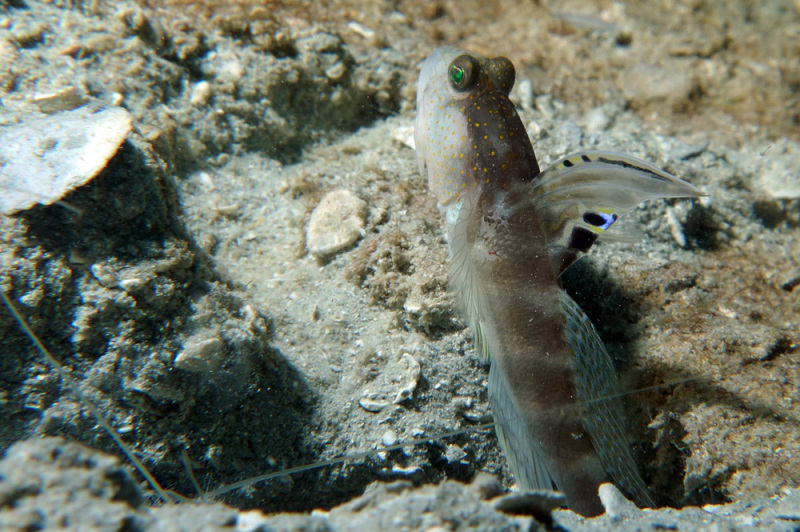- Classification
- ACTINOPTERYGII
- PERCIFORMES
- GOBIIDAE
- Mahidolia
- mystacina
Smiling Goby, Mahidolia mystacina (Valenciennes 1837)
Other Names: Flagfin Prawngoby, Flagfin Shrimpgoby

A Smiling Goby, Mahidolia mystacina, on the northeast coast of Lizard Island, Great Barrier Reef, Queensland, depth 24 m. Source: Lyle Vail / Lizard Island Field Guide, http://lifg.australianmuseum.net.au/. License: CC by Attribution-NonCommercial-ShareAlike
Summary:
A pale grey to yellowish or dark brown shrimpgoby with six diagonal brown bands, orange spots and lines on the head, and dark bands and/or one or more blue to black spots on the first dorsal fin. The coloration and shape of the first dorsal fin is highly variable.
Cite this page as:
Bray, D.J. 2019, Mahidolia mystacina in Fishes of Australia, accessed 20 Apr 2024, https://fishesofaustralia.net.au/Home/species/3062
Smiling Goby, Mahidolia mystacina (Valenciennes 1837)
More Info
|
Distribution |
Recorded in Australia from Darwin, Northern Territory, to Cape Ferguson, Queensland. Elsewhere the species occurs in the tropical, Indo-west-central Pacific. Inhabits silty and muddy areas in estuaries, mangroves, the lower reaches of rivers and on coastal reefs. |
|
Remarks |
Thacker et al. (2011) found evidence of potential cryptic species within the current understanding of Mahidolia mystacina. |
|
Etymology |
The specific name mystacinus is from the Greek mystax meaning 'upper lip', and the Latin inus meaning 'belonging to'. |
|
Species Citation |
Gobius mystacinus Valenciennes, 1837, Hist. Nat. Poiss. 12: 124. Type locality: Java. |
|
Author |
Bray, D.J. 2019 |
|
Resources |
Smiling Goby, Mahidolia mystacina (Valenciennes 1837)
References
Allen, G.R. & Erdmann, M.V. 2012. Reef fishes of the East Indies. Perth : Tropical Reef Research 3 vols, 1260 pp.
Hoese, D.F. 1986. Family No. 240: Gobiidae. pp. 774-807 figs in Smith, M.M. & Heemstra, P.C. (eds). Smith's Sea Fishes. Johannesburg : Macmillan South Africa xx + 1047 pp. 144 pls.
Kuiter, R.H. 1992. Tropical Reef-Fishes of the Western Pacific, Indonesia and Adjacent Waters. Jakarta : PT Gramedia Pustaka Utama 314 pp. pls.
Kuiter, R.H. 1996. Guide to Sea Fishes of Australia. A comprehensive reference for divers and fishermen. Sydney, NSW, Australia : New Holland Publishers xvii, 434 pp.
Larson, H. 2016. Mahidolia mystacina. The IUCN Red List of Threatened Species 2016: e.T192982A2180744. http://dx.doi.org/10.2305/IUCN.UK.2016-3.RLTS.T192982A2180744.en. Downloaded on 21 August 2019.
Larson, H.K. & Lim, K.K.P. 2005. A guide to the gobies of Singapore. Singapore : Singapore Science Centre 164 pp.
Larson, H.K. & Williams, R.S. 1997. Darwin Harbour fishes: a survey and annotated checklist. pp. 339-380 in Hanley, H.R., Caswell, G., Megirian, D. & Larson, H.K. (eds). The Marine Flora and Fauna of Darwin Harbour, Northern Territory, Australia. Proceedings of the Sixth International Marine Biology Workshop. Darwin : Museum and Art Gallery of the Northern Territory 466 pp.
Macleay, W.J. 1878. The fishes of Port Darwin. Proceedings of the Linnean Society of New South Wales 1 2(4): 344-367 pls 7-10
Myers, R.F. 1999. Micronesian Reef Fishes. A comprehensive guide to the coral reef fishes of Micronesia. Guam : Coral Graphics vi 330 pp. 192 pls.
Randall, J.E. 2005. Reef and shore fishes of the South Pacific. New Caledonia to Tahiti and the Pitcairn Islands. Honolulu : University of Hawaii Press 707 pp.
Smith, H.M. 1941. The gobies Waitea and Mahidolia. Journal of the Washington Academy of Sciences 31(9): 409-415 figs 1-2
Thacker, C.E., Thompson, A.R. & Roje, D.M. 2011. Phylogeny and evolution of Indo-Pacific shrimp-associated gobies (Gobiiformes: Gobiidae). Molecular Phylogenetics and Evolution 59: 168-176.
Valenciennes, A. in Cuvier, G.L. & Valenciennes, A. 1837. Histoire Naturelle des Poissons. Paris : Levrault Vol. 12 507 pp. pls 344-368.
Yanagisawa, Y. 1978. Studies on the interspecific relationship between gobiid fish and snapping shrimp. I. Gobiid fishes associated with snapping shrimps in Japan. Publications of the Seto Marine Biological Laboratory 24(4/6): 269-325 figs 1-23 pls 1-3





